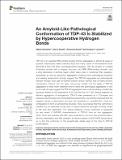Por favor, use este identificador para citar o enlazar a este item:
http://hdl.handle.net/10261/153043COMPARTIR / EXPORTAR:
 SHARE SHARE
 CORE
BASE CORE
BASE
|
|
| Visualizar otros formatos: MARC | Dublin Core | RDF | ORE | MODS | METS | DIDL | DATACITE | |

| Título: | An Amyloid-Like Pathological Conformation of TDP-43 Is Stabilized by Hypercooperative Hydrogen Bonds |
Autor: | Mompeán, Miguel CSIC ORCID ; Baralle, Marco; Buratti, Emanuele; Laurents, Douglas V. CSIC ORCID | Fecha de publicación: | 17-nov-2016 | Editor: | Frontiers Media | Citación: | Front. Mol. Neurosci. 9: 125 (2016) | Resumen: | TDP-43 is an essential RNA-binding protein forming aggregates in almost all cases of sporadic amyotrophic lateral sclerosis (ALS) and many cases of frontotemporal lobar dementia (FTLD) and other neurodegenerative diseases. TDP-43 consists of a folded N-terminal domain with a singular structure, two RRM RNA-binding domains, and a long disordered C-terminal region which plays roles in functional RNA regulatory assemblies as well as pernicious aggregation. Evidence from pathological mutations and seeding experiments strongly suggest that TDP-43 aggregates are pathologically relevant through toxic gain-of-harmful-function and/or harmful loss-of-native-function mechanisms. Recent, but not early, microscopy studies and the ability of TDP-43 aggregates to resist harsh treatment and to seed new pathological aggregates in vitro and in cells strongly suggest that TDP-43 aggregates have a self-templating, amyloid-like structure. Based on the importance of the Gln/Asn-rich 341–367 residue segment for efficient aggregation of endogenous TDP-43 when presented as a 12X-repeat and extensive spectroscopic and computational experiments, we recently proposed that this segment adopts a beta-hairpin structure that assembles in a parallel with a beta-turn configuration to form an amyloid-like structure. Here, we propose that this conformer is stabilized by an especially strong class of hypercooperative hydrogen bonding unique to Gln and Asn sidechains. The clinical existence of this conformer is supported by very recent LC-MS/MS characterization of TDP-43 from ex vivo aggregates, which show that residues 341–367 were protected in vivo from Ser phosphorylation, Gln/Asn deamidation and Met oxidation. Its distinct pattern of SDS-PAGE bands allows us to link this conformer to the exceptionally stable seed of the Type A TDP-43 proteinopathy. | Versión del editor: | http://dx.doi.org/10.3389/fnmol.2016.00125 | URI: | http://hdl.handle.net/10261/153043 | DOI: | 10.3389/fnmol.2016.00125 | ISSN: | 1662-5099 |
| Aparece en las colecciones: | (IQF) Artículos |
Ficheros en este ítem:
| Fichero | Descripción | Tamaño | Formato | |
|---|---|---|---|---|
| Amyloid-Like Pathological Conformation of TDP-43.pdf | 993,43 kB | Adobe PDF |  Visualizar/Abrir |
CORE Recommender
PubMed Central
Citations
16
checked on 28-mar-2024
SCOPUSTM
Citations
30
checked on 16-abr-2024
WEB OF SCIENCETM
Citations
29
checked on 22-feb-2024
Page view(s)
340
checked on 23-abr-2024
Download(s)
170
checked on 23-abr-2024

